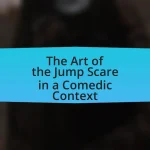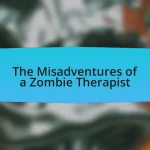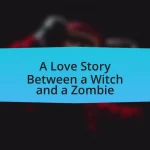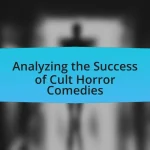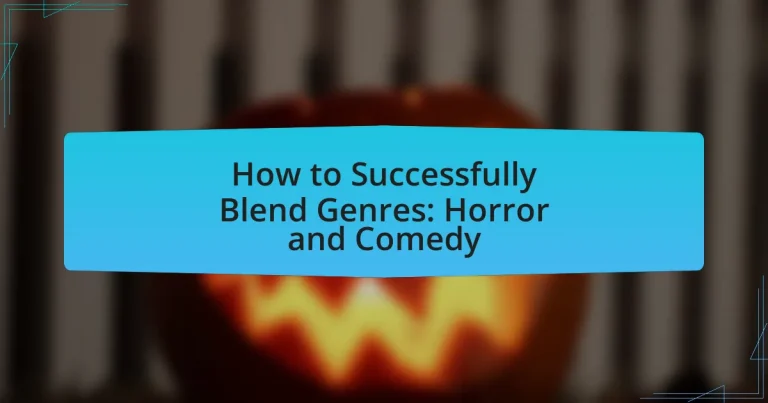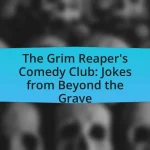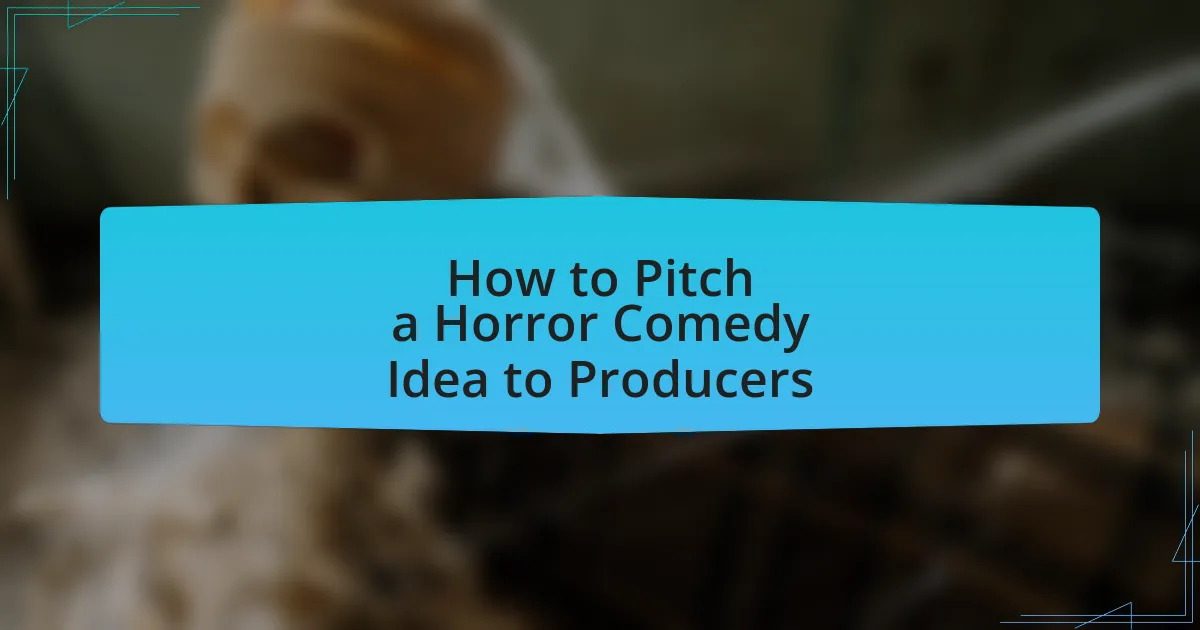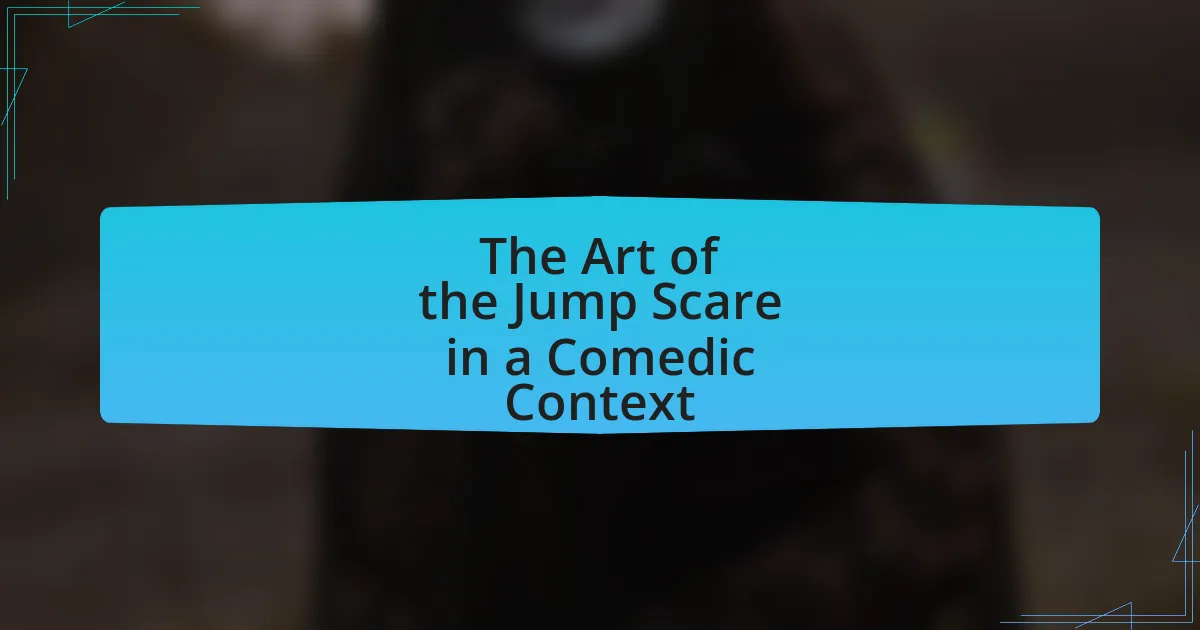The article focuses on the successful blending of horror and comedy genres, exploring how these two seemingly opposing elements can create a unique narrative experience. It discusses the emotional interplay between fear and humor, highlighting techniques such as juxtaposition, timing, and character development that enhance audience engagement. Key examples, including films like “Shaun of the Dead” and “What We Do in the Shadows,” illustrate effective genre fusion and its appeal to viewers. Additionally, the article examines the psychological effects of horror-comedy films, common pitfalls to avoid, and practical tips for writers and filmmakers aiming to achieve a cohesive tone that balances both genres.
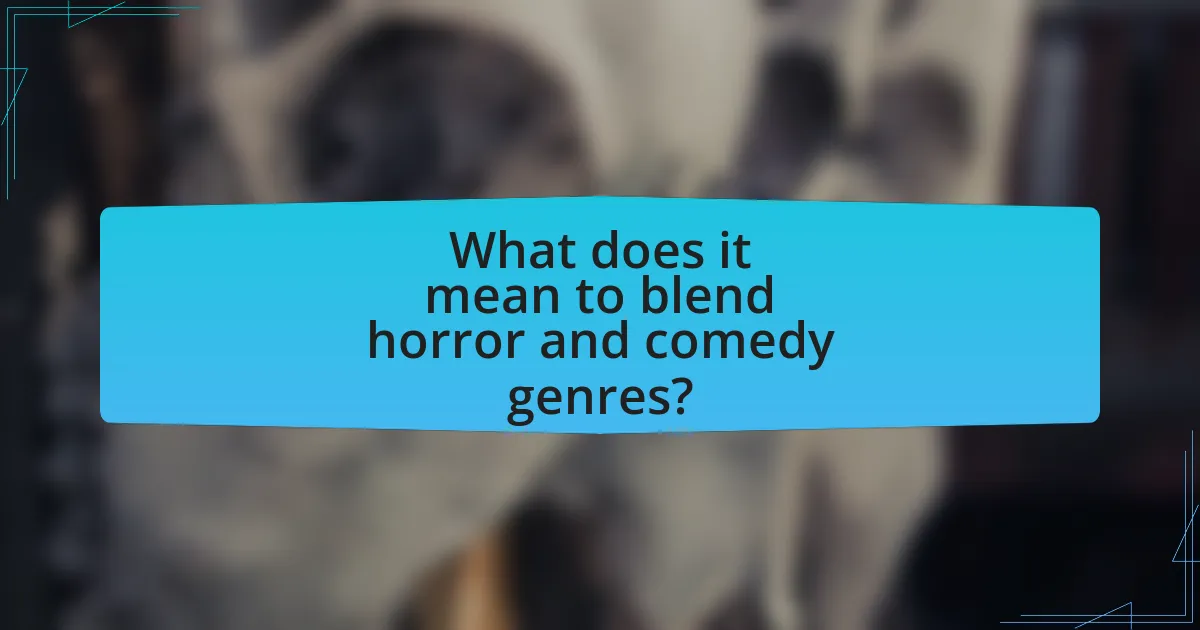
What does it mean to blend horror and comedy genres?
Blending horror and comedy genres means combining elements of fear and humor to create a unique narrative experience. This fusion allows for the juxtaposition of terrifying scenarios with comedic relief, often resulting in a heightened emotional response from the audience. Films like “Shaun of the Dead” exemplify this blend by using horror tropes, such as zombies, while incorporating humor through character interactions and absurd situations. This combination can effectively engage viewers by providing both thrills and laughter, making the horror more palatable and the comedy more impactful.
How do horror and comedy complement each other in storytelling?
Horror and comedy complement each other in storytelling by creating a dynamic interplay that enhances emotional engagement. The juxtaposition of fear and humor can heighten tension and provide relief, making the overall experience more impactful. For instance, films like “Shaun of the Dead” effectively use comedic elements to diffuse horror, allowing audiences to process fear while still enjoying the narrative. This blending can also lead to a unique storytelling rhythm, where moments of levity serve to amplify the shock of horror, as seen in “Tucker and Dale vs. Evil.” Research indicates that the combination of these genres can lead to increased viewer satisfaction, as audiences appreciate the unpredictability and emotional rollercoaster that arises from such contrasts.
What are the key elements of horror that can enhance comedic moments?
The key elements of horror that can enhance comedic moments include tension, absurdity, and the juxtaposition of fear and humor. Tension creates a buildup that can lead to comedic relief when the anticipated scare is subverted, as seen in films like “Shaun of the Dead,” where moments of suspense are followed by humorous outcomes. Absurdity in horror, such as exaggerated monsters or ridiculous scenarios, can evoke laughter by highlighting the ridiculousness of the situation, as demonstrated in “Tucker and Dale vs. Evil.” The juxtaposition of fear and humor allows audiences to experience a rollercoaster of emotions, making the comedic moments more impactful after a scare. This blending of genres effectively engages viewers by playing with their expectations and emotions.
How can comedic elements alleviate tension in horror narratives?
Comedic elements can alleviate tension in horror narratives by providing moments of relief that disrupt the buildup of fear. This technique allows audiences to experience a balance between suspense and humor, which can enhance engagement with the story. For instance, the juxtaposition of a frightening scenario followed by a humorous reaction or dialogue can create a contrast that diffuses anxiety. Research indicates that humor activates the brain’s reward system, releasing dopamine, which can counteract the stress response triggered by horror elements. This interplay between fear and laughter not only maintains viewer interest but also fosters a more enjoyable overall experience.
Why is blending horror and comedy appealing to audiences?
Blending horror and comedy is appealing to audiences because it creates a unique emotional experience that allows viewers to confront fear while simultaneously finding humor in it. This juxtaposition can lead to heightened engagement, as laughter serves as a coping mechanism for the tension and fear generated by horror elements. Research indicates that the combination of these genres can enhance audience enjoyment, as seen in films like “Shaun of the Dead,” which successfully merges comedic moments with traditional horror tropes, resulting in critical and commercial success. The ability to oscillate between fear and laughter keeps audiences on their toes, making the viewing experience more dynamic and memorable.
What psychological effects do horror-comedy films have on viewers?
Horror-comedy films elicit a unique psychological response in viewers by combining fear and humor, which can lead to increased emotional resilience and catharsis. This genre allows audiences to confront their fears in a safe environment, often resulting in laughter that mitigates anxiety and stress associated with horror elements. Research indicates that the juxtaposition of comedic relief can enhance enjoyment and reduce the intensity of fear responses, as seen in studies like those conducted by the University of California, which found that humor can lower physiological arousal linked to fear. Additionally, horror-comedy films can foster social bonding among viewers, as shared laughter in the face of fear creates a communal experience, reinforcing social connections.
How does the juxtaposition of fear and laughter create a unique experience?
The juxtaposition of fear and laughter creates a unique experience by eliciting contrasting emotional responses that heighten engagement and enjoyment. This interplay allows audiences to navigate tension and release, as fear can amplify the impact of humor, making comedic moments feel more rewarding. For instance, studies in psychology indicate that laughter can serve as a coping mechanism, reducing the physiological effects of fear, which enhances the overall experience of horror-comedy films. This dynamic is evident in successful works like “Shaun of the Dead,” where moments of genuine terror are immediately followed by humor, creating a rollercoaster of emotions that keeps viewers invested.
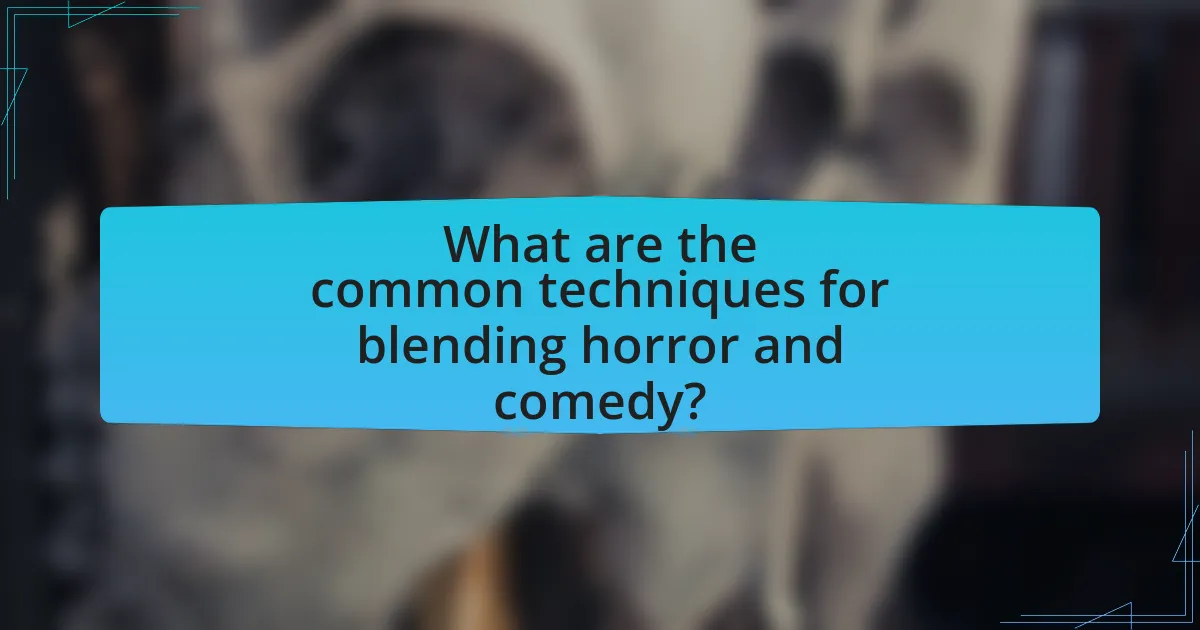
What are the common techniques for blending horror and comedy?
Common techniques for blending horror and comedy include the use of juxtaposition, absurdity, and parody. Juxtaposition involves placing frightening elements alongside humorous ones to create a contrast that elicits laughter amidst fear. Absurdity plays on the ridiculousness of situations, often exaggerating horror tropes to a point where they become comical. Parody involves mimicking horror conventions in a humorous way, allowing audiences to recognize and laugh at familiar clichés. These techniques are effective because they exploit the emotional responses of fear and laughter, creating a unique viewing experience that engages audiences on multiple levels.
How can timing and pacing influence the effectiveness of horror-comedy?
Timing and pacing are crucial in enhancing the effectiveness of horror-comedy by balancing suspense and humor. Effective timing allows for the buildup of tension, which can then be punctuated by comedic relief, creating a rhythm that engages the audience. For instance, a well-timed jump scare followed immediately by a humorous reaction can amplify both the fright and the laughter, making the experience more memorable. Research indicates that the juxtaposition of horror and comedy relies heavily on timing; a study published in the Journal of Media Psychology highlights that audiences respond positively to the unexpected shifts between fear and humor, as they create a unique emotional rollercoaster. Thus, precise pacing ensures that the comedic elements do not undermine the horror, while also preventing the horror from becoming overwhelming, ultimately leading to a more effective blend of the two genres.
What role does comedic timing play in horror scenarios?
Comedic timing serves as a crucial element in horror scenarios by creating a juxtaposition that heightens both fear and humor. This timing allows for moments of levity that can relieve tension, making the subsequent scares more impactful. For instance, films like “Shaun of the Dead” effectively use comedic pauses before a horror element to amplify the shock value, demonstrating that well-placed humor can enhance the overall experience. Research indicates that the brain processes humor and fear in similar ways, suggesting that effective comedic timing can manipulate audience emotions, leading to a more engaging narrative.
How can pacing shifts enhance both horror and comedic elements?
Pacing shifts can enhance both horror and comedic elements by manipulating the audience’s emotional response through timing and rhythm. In horror, a sudden change to a slower pace can build tension, allowing fear to escalate before a shocking moment, while a rapid pace can create a sense of chaos and urgency. Conversely, in comedy, a quick pacing can deliver punchlines effectively, while a deliberate slowdown can heighten anticipation and allow for comedic timing. Research indicates that effective pacing in film can significantly impact audience engagement and emotional reactions, as seen in studies on viewer responses to horror and comedy films, which demonstrate that pacing directly influences the effectiveness of both genres.
What types of humor work best in horror settings?
Dark humor works best in horror settings, as it effectively juxtaposes comedic elements with macabre themes. This type of humor allows audiences to confront fear and discomfort through laughter, creating a unique emotional experience. For instance, films like “Shaun of the Dead” and “Tucker and Dale vs. Evil” utilize dark humor to highlight absurdity in terrifying situations, making the horror more palatable while still engaging the audience’s sense of dread. Additionally, self-referential humor, where characters acknowledge horror tropes, can enhance the comedic effect by subverting expectations, as seen in “Scream.” These approaches demonstrate that humor can serve as a coping mechanism, allowing viewers to navigate the tension inherent in horror narratives.
How can dark humor be effectively integrated into horror narratives?
Dark humor can be effectively integrated into horror narratives by using comedic elements to provide relief from tension while simultaneously enhancing the horror experience. This technique allows for a juxtaposition of fear and laughter, creating a unique emotional response that can deepen audience engagement. For instance, films like “Shaun of the Dead” demonstrate this blend by incorporating witty dialogue and absurd situations amidst a zombie apocalypse, which not only entertains but also critiques societal norms regarding fear and survival. The effectiveness of this integration lies in the timing and delivery of humor, ensuring it complements rather than undermines the horror elements, as evidenced by the success of horror-comedy hybrids in both film and literature.
What are the risks of using slapstick comedy in horror films?
The risks of using slapstick comedy in horror films include undermining the tension and emotional impact of horror elements. When slapstick humor is introduced, it can distract the audience from the intended fear and suspense, leading to a disjointed viewing experience. For example, films like “Scary Movie” demonstrate how excessive comedic elements can dilute the horror narrative, resulting in a loss of audience investment in the characters’ peril. Additionally, the juxtaposition of slapstick with horror can alienate viewers who prefer a more traditional horror experience, potentially limiting the film’s audience appeal.
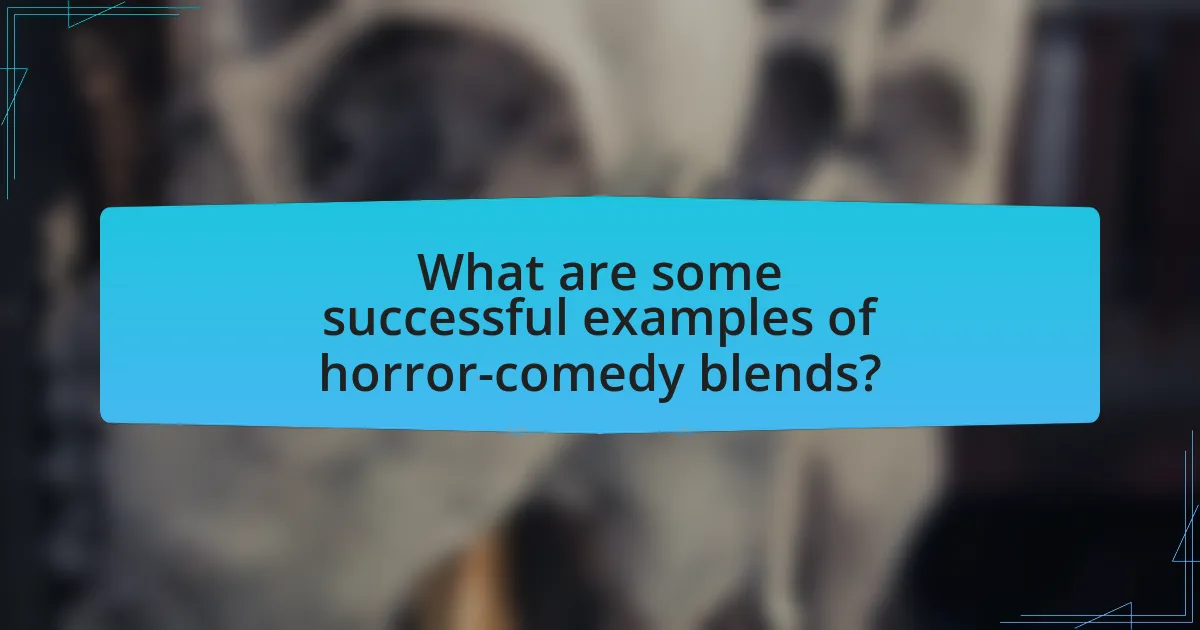
What are some successful examples of horror-comedy blends?
Successful examples of horror-comedy blends include “Shaun of the Dead,” “What We Do in the Shadows,” and “Tucker and Dale vs. Evil.” “Shaun of the Dead,” directed by Edgar Wright, combines zombie horror with British humor, achieving critical acclaim and a strong box office performance, grossing over $30 million worldwide. “What We Do in the Shadows,” a mockumentary by Jemaine Clement and Taika Waititi, cleverly mixes vampire lore with comedic elements, receiving positive reviews and a cult following. “Tucker and Dale vs. Evil,” directed by Eli Craig, subverts horror tropes by portraying the misunderstood hillbillies as the protagonists, earning praise for its humor and originality. These films exemplify how effective blending of horror and comedy can resonate with audiences, both critically and commercially.
How have films like “Shaun of the Dead” and “What We Do in the Shadows” achieved success?
Films like “Shaun of the Dead” and “What We Do in the Shadows” have achieved success by effectively blending horror and comedy, creating a unique viewing experience that appeals to a broad audience. “Shaun of the Dead” combines traditional zombie horror elements with humor, utilizing clever writing and relatable characters to engage viewers, which contributed to its critical acclaim and box office success, grossing over $30 million worldwide. Similarly, “What We Do in the Shadows” employs a mockumentary style to present vampire lore in a comedic light, resonating with audiences and earning a cult following, as evidenced by its 96% approval rating on Rotten Tomatoes. Both films showcase how genre blending can attract diverse audiences while maintaining strong storytelling and character development.
What specific techniques did these films use to balance horror and comedy?
Films that successfully balance horror and comedy often employ techniques such as juxtaposition, timing, and character development. Juxtaposition involves placing comedic elements alongside horror scenes to create a contrast that enhances both genres; for example, a character might deliver a humorous one-liner just after a tense moment, diffusing fear while maintaining engagement. Timing is crucial, as comedic beats must be carefully placed to provide relief without undermining the horror; effective use of pauses and pacing can amplify the impact of both laughter and scares. Additionally, character development allows for relatable protagonists whose humorous traits make them more endearing, thus heightening the emotional stakes when they face horror elements. These techniques are evident in films like “Shaun of the Dead,” where the blend of humor and horror is executed through sharp dialogue and situational comedy, demonstrating the effectiveness of this genre fusion.
How did audience reception vary between horror and comedy elements in these films?
Audience reception varied significantly between horror and comedy elements in these films, with horror often eliciting stronger emotional responses while comedy provided relief and enjoyment. Research indicates that horror films tend to engage viewers through suspense and fear, leading to heightened physiological reactions, such as increased heart rates, as evidenced by studies measuring audience responses during key scenes. In contrast, comedy elements are generally received positively, as they create laughter and a sense of enjoyment, often resulting in higher overall satisfaction ratings among viewers. For instance, a survey conducted by the American Film Institute found that audiences rated films with effective comedic elements higher in enjoyment compared to those that relied solely on horror. This demonstrates that while horror can captivate through tension, comedy serves to enhance viewer experience by balancing the emotional landscape of the film.
What lessons can be learned from successful horror-comedy films?
Successful horror-comedy films teach the importance of balancing humor and suspense to engage audiences effectively. By integrating comedic elements with horror tropes, filmmakers can create a unique viewing experience that appeals to a broader audience. For instance, films like “Shaun of the Dead” and “What We Do in the Shadows” demonstrate that well-timed humor can alleviate tension, making horror scenes more impactful. Additionally, these films often utilize relatable characters and absurd situations, which enhance the comedic effect while maintaining the horror atmosphere. This blend not only entertains but also allows for social commentary, as seen in “Get Out,” where humor is used to address serious themes.
How can aspiring filmmakers apply these lessons to their own projects?
Aspiring filmmakers can apply the lessons of blending horror and comedy by strategically incorporating humor into suspenseful moments to create a unique viewing experience. For instance, they can study successful films like “Shaun of the Dead,” which effectively uses comedic elements to relieve tension while maintaining the horror genre’s core aspects. By analyzing the timing and delivery of jokes in relation to horror tropes, filmmakers can learn to balance both genres, enhancing audience engagement. Additionally, they should experiment with character development, ensuring that comedic relief does not undermine the stakes of the horror elements, as seen in films like “What We Do in the Shadows.” This approach allows filmmakers to create a cohesive narrative that resonates with diverse audiences.
What common pitfalls should be avoided when blending these genres?
When blending horror and comedy, one common pitfall to avoid is failing to balance the tonal shifts between fear and humor. This imbalance can lead to confusion for the audience, making it difficult for them to engage with the narrative. For instance, if a horror scene is abruptly followed by a comedic moment without proper transition, it can undermine the tension built in the horror segment, resulting in a disjointed viewing experience. Additionally, relying too heavily on clichés from either genre can make the blend feel unoriginal and predictable, which detracts from the overall impact. Maintaining a clear understanding of the audience’s expectations for both genres is crucial; if the humor overshadows the horror or vice versa, the intended effect of the blend may be lost.
What practical tips can help in successfully blending horror and comedy?
To successfully blend horror and comedy, creators should focus on timing, character development, and the juxtaposition of fear and humor. Effective timing ensures that comedic moments provide relief from tension, while well-developed characters allow audiences to connect emotionally, making both horror and comedy more impactful. The juxtaposition of fear and humor can create a unique experience, as seen in films like “Shaun of the Dead,” where the absurdity of situations enhances the horror elements. This approach is validated by audience reactions, which often show that laughter can heighten the suspense, making the horror more effective.
How can writers develop a cohesive tone that balances both genres?
Writers can develop a cohesive tone that balances both horror and comedy by carefully integrating elements from each genre while maintaining a consistent voice. This involves using humor to diffuse tension in horror scenes and employing suspenseful elements to enhance comedic moments. For instance, the juxtaposition of a frightening scenario with a humorous character reaction can create a unique blend that resonates with audiences. Research indicates that successful genre blending often relies on the timing and delivery of jokes, as well as the pacing of suspenseful moments, to ensure that neither genre overshadows the other.
What strategies can be used to test audience reactions to horror-comedy elements?
To test audience reactions to horror-comedy elements, filmmakers can employ strategies such as focus groups, test screenings, and surveys. Focus groups allow for in-depth discussions where participants can express their feelings about specific scenes, helping to gauge the effectiveness of humor and horror integration. Test screenings provide real-time audience reactions, enabling filmmakers to observe laughter and fright responses, which can be quantified for analysis. Surveys can be distributed post-screening to collect data on audience enjoyment, emotional responses, and preferences regarding the balance of horror and comedy. These methods are supported by industry practices, as evidenced by successful films like “Shaun of the Dead,” which utilized audience feedback to refine comedic timing and horror elements.

